Digital Marketing Strategy Frameworks for Business Growth
TL;DR
Why You Need a Digital Marketing Strategy Framework
Okay, so you're probably wondering why you even need a digital marketing strategy framework, right? Well, let me tell you, it's kinda like trying to build a house without blueprints - you might get something standing, but it probably won't be pretty or functional.
Lots of businesses are just throwing random marketing stuff out there, hoping something sticks. It's like they're firing darts in the dark, and that's a waste of time and money, honestly.
Without a framework, you can't see how all the pieces connect. So, you don't know if your social media is helping your email list, or if your ads are even bringing in the right people.
You're also missing chances to really grab your audience. Think about it: healthcare companies could be using personalized content to help patients manage their conditions, or financial firms could be offering tailored advice through webinars. A framework helps you identify these specific customer needs and create targeted content, like a personalized health tip based on a patient's condition or a webinar addressing common financial planning concerns for a specific demographic. But without a framework, these opportunities just slip through the cracks.
A digital marketing strategy framework gives you a map to follow. It's a structured approach for hitting your business goals. Think of it as your GPS for growth.
It makes sure everyone’s on the same page. No more marketing efforts going in different directions, which honestly, happens a lot.
It helps you figure out what's most important. No more just throwing money at the wall and seeing what happens. You can actually focus on what's gonna give you the biggest bang for your buck—finally.
Better roi. That's return on investment, for those not in the know. By focusing your resources on high-impact activities and optimizing your targeting, you'll see those numbers climb.
More people know your brand and actually care. Brand awareness is cool and all, but engagement is where it's at. Engagement means customers are interacting with your brand, which often leads to stronger loyalty, higher conversion rates, and even advocacy.
You'll get how customers tick and make their journey smoother. Like, you'll really understand what they want, and when they want it.
Keeps you ahead of the game. the digital world changes fast, but a framework helps you stay sharp.
So, now that we've covered why you need a digital marketing strategy framework, let's dive into what that actually looks like.
Key Digital Marketing Strategy Frameworks for Growth
Alright, so you're probably thinking, "Okay, frameworks, sounds boring." But trust me, it's where the magic happens.
Think of frameworks as the Avengers of your marketing strategy—each one has unique powers. The right ones can seriously level up your game. Understanding the 'why' behind needing a framework naturally leads us to explore the 'what' – the specific tools that can help.
For Customer Retention and Loyalty
The RACE Framework: Reach, Act, Convert, Engage
RACE is all about the customer journey, right from "Hey, look at me!" to "I'm a loyal fan!". It's a step-by-step guide, covering everything from building awareness to turning folks into repeat customers.
Reach is all about getting noticed. Think ads, social media, and content that just grabs eyeballs.
Act gets people involved. It could be signing up for a newsletter or just clicking a link. You want them to do something.
Convert is where the magic happens—turning that engagement into sales. Irresistible offers and clear calls to action are your best friends here.
Engage strengthens those customer relationships. The goal? Loyalty and repeat purchases. Send personalized guides, exclusive deals, the works.
For example, a travel agency could use google ads to reach potential travelers, blog posts about travel tips to get them to act, limited-time discounts to convert them, and personalized destination guides to keep them engaged.
Track key stuff at each stage. Impressions and click-through rates for Reach, engagement metrics for Act, conversion rates for Convert, and customer retention for Engage.
The Flywheel Model: Attract, Engage, Delight
- Forget the linear funnel. The Flywheel is all about creating a continuous loop of happy customers who fuel growth.
- Attract customers with helpful content and strong seo.
- Engage them with personalized experiences.
- Delight them by exceeding their expectations.
- An ecommerce store might use engaging tutorials to attract, personalized recommendations to engage, and exclusive discounts to delight customers.
For Startups and General Business Analysis
Pirate Metrics (AARRR): Acquisition, Activation, Retention, Referral, Revenue
- Pirate metrics are a set of key performance indicators (KPIs) that help startups understand and grow their business. They focus on the customer journey from first contact to becoming a paying, referring customer.
- Acquisition: How do customers find you? (e.g., website traffic, app downloads)
- Activation: Do customers have a great first experience? (e.g., completing onboarding, first use of a key feature)
- Retention: Do customers keep coming back? (e.g., repeat purchases, daily/monthly active users)
- Referral: Do customers tell others about you? (e.g., net promoter score, referral program sign-ups)
- Revenue: How do you make money? (e.g., average order value, customer lifetime value)
- Startups use these metrics to identify bottlenecks in their growth and prioritize where to focus their efforts.
SWOT Analysis: Strengths, Weaknesses, Opportunities, Threats
- Swot is your business's mirror. It shows what you're good at and where you suck, plus what's out there that could help or hurt you. It’s a simple but powerful tool for understanding where you stand.
- Strengths: What does your business do well? What internal advantages do you have?
- Weaknesses: Where can you improve? What’s holding you back?
- Opportunities: What trends or untapped markets can you jump on?
- Threats: What external challenges could mess things up?
- A software company might find that killer customer service is a strength, and a slow website is a weakness. A growing demand for ai solutions is an opportunity, while increasing competition is a threat. Quarterly SWOT check-ins are a must.
For E-commerce and Customer Journey Mapping
- Marketing Funnel: Awareness, Interest, Consideration, Decision, Retention, Advocacy
- The Marketing Funnel maps out the whole customer journey, from initial "Hey, I exist!" to turning them into raving fans.
- Start with Awareness. Introduce your brand and grab attention.
- Next, Interest. Spark curiosity with killer content.
- Then, Consideration. Show why you're the best choice.
- Decision time. Convert those leads into paying customers. For a subscription box, this could be a clear pricing page with different plan options and a prominent "Sign Up Now" button.
- Retention. Keep 'em hooked with personalized experiences. This might involve sending personalized product recommendations based on past box contents or offering early access to new features.
- Finally, Advocacy. Turn happy customers into brand ambassadors.
- For example, a subscription box service might use instagram ads to create awareness, unboxing videos to spark interest, limited-time trials for consideration, and a referral program for advocacy.
For Large Organizations and Strategic Alignment
- McKinsey’s 7S Framework
- This framework looks at seven key internal elements that need to be aligned for an organization to be successful. It's particularly useful for businesses with larger teams and budgets, as it emphasizes the interconnectedness of strategy, structure, and culture.
- The seven elements are:
- Strategy: The plan to achieve competitive advantage.
- Structure: How the organization is organized (e.g., hierarchy, departments).
- Systems: The daily activities and processes within the organization.
- Shared Values: The core beliefs and guiding principles.
- Style: The leadership approach and organizational culture.
- Staff: The employees and their capabilities.
- Skills: The distinctive capabilities of the organization.
- For example, a company might have a great strategy but fail if its structure doesn't support it, or if its employees lack the necessary skills.
For Building Online Communities and Engagement
- Forrester’s 5 is: Involvement, Interaction, Intimacy, Influence, Individualization
- The "5 is" is about building online communities that keep customers engaged and loyal.
- Involvement: Get customers to engage with reviews and feedback.
- Interaction: Be there when they need you with quick responses.
- Intimacy: Build trust with personalized recommendations.
- Influence: Highlight user-generated content like reviews.
- Individualization: Personalize offers based on their behavior.
- Amazon nails this. Prime perks for involvement, fast support for interaction, tailored recommendations for intimacy, prominent reviews for influence, and exclusive deals for individualization. For example, Amazon might show you a deal on a book because you recently bought a similar title, demonstrating personalization based on your purchase behavior.
These aren't just theories. Leading companies use these frameworks every day to grow. Remember, it's not about picking one framework and sticking to it forever. It's about finding what works for you and tweaking it as you go.
Now that you're familiar with these key frameworks, let's explore how to choose the right one for your business.
Choosing the Right Framework for Your Business
Alright, so you've got all these frameworks, but how do you, like, actually pick one? It's not as scary as it sounds, promise. It's kinda like dating, you know? You gotta find the one that clicks.
First off, what are you tryna do? Seriously, sit down and actually think about it. Is it more leads? Happier customers? Or just, like, getting your name out there? Keeping your goals front and center is key.
- If you're all about keeping customers around and nurturing them through their journey, the marketing funnel is your jam, it's great for retention.
- And if you're a startup trying to scale fast and understand your core growth drivers, pirate metrics might just be your bff.
- For e-commerce businesses focused on the entire customer journey from discovery to loyalty, the RACE framework can be incredibly effective.
- If you're in the subscription biz and want to build a continuous loop of happy customers fueling growth, the flywheel model could be your soulmate.
Be real with yourself here. Got a huge team and a massive budget? McKinsey’s 7S might be your thing, helping align all those moving parts. A smaller team? No worries! A SWOT analysis or pirate metrics are simple and to the point, helping you focus on what matters most.
Don't try to run before you can walk, or something like that. No one wants to overstretch themselves, and that's a fact.
So, you've (hopefully) picked a framework, now what? Well, it's time to get to work.
Real-World Examples of Framework Implementation
Alright, so you've picked a framework—now what? It's time to see it work in the real world, right? Let's look at how some companies put these frameworks into action.
The RACE framework is super practical for e-commerce. Businesses use it to map out their entire customer journey. For instance, they use targeted ads to reach potential buyers, engaging product descriptions to get them to act, and a streamlined checkout to convert them into paying customers. Loyalty programs then engage them over the long term.
Startups, SaaS or otherwise, love SWOT. It's a great tool for figuring out what they're good at and where they need help. A SaaS company might leverage its innovative tech (strength) to address the growing demand for cloud solutions (opportunity) while figuring out how to tackle its limited marketing budget (weakness) and competition from established players (threats).
Subscription services use the Flywheel model to build lasting customer relationships. They attract customers with helpful content, engage them with personalized recommendations, and delight them with exclusive discounts.
So, that's how frameworks help businesses grow, in a nutshell. Now, go forth and use them!




